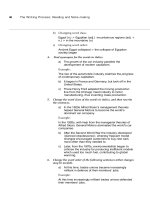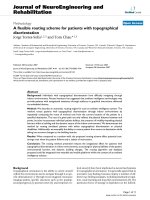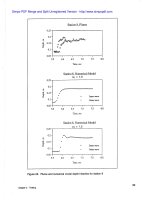A Finite Element Scheme for Shock Capturing Part 5 pdf
Bạn đang xem bản rút gọn của tài liệu. Xem và tải ngay bản đầy đủ của tài liệu tại đây (265.5 KB, 10 trang )
The numerical grid is shown
in
Figure 23, and contains 698 elements and
811 nodes. This grid was reached by increasing the resolution until the results
no longer changed. The most critical reach is in the region of the contraction
near the dam breach. The basic element length in the channel is 0.1 m and
there are five elements across the channel width. For the smooth channel case,
Bell, Elliot, and Chaudhry (1992) used a
1-D
calculation to estimate the
Manning's n to be 0.016 but experience at the Waterways Experiment Station
suggests that this value should actually be 0.009, which seems more
reasonable.
The test results for stations 4, 6 and 8 are shown in Figures 24-26.
Here
the time-history of the water elevation is shown for the inside and outside of
the channel for both the numerical model (at
5
of 1.0 and
1.5)
and the flume.
The inside wall is designated by squares and the outside by diamonds. Of
particular importance is the arrival time of the shock front. At station 4 the
numerical prediction of arrival time using
5
of 1.0 is about 3.4 sec which
appears
to
be about 0.05 sec sooner than for the flume. This is roughly
1-2 percent fast. For
9
of
1.5
the time of arrival is 3.55 sec which is about
0.1
sec late
(3
percent). At station 6 both flume and numerical model arrival
times for
at
of 1.0 were about 4.3
sec
and for slation 8 the numerical model is
5.6
sec and the flume is 5.65 to
5.8
sec. With % set at 1.5 the time of arrival
is late by about 0.2 and 0.15
sec at stations 6 and
8,
respectively. The flume
at stations
6
and
8
has a earlier arrival time for the outer wave connpared to
the inner wave. The numerical model does not show this.
In comparing the
water
ellevations between the flume and the numerical model, it is apparent that
the flume results show a more rapid rise. The numerical model is smeared
somewhat in time, likely as a result of the first-order temporal derivative
calculation of
5
of 1.0. The numerical model with
at
set at 1.5 shows the
overshoot that was demonstrated in Case
1.
This is likely a numerical artifact
and not based upon physics even though this looks much like the flume
results. The surge elevations predicted by the numerical
modd are fairly close
if one notices that the initial elevation of the flume data is supposed to be
0.0762 m and it appears to be recorded as much as 0.015
rn
higher at some
gages. Since the velocity is initially zero then all of these readings should
have been 0.0762 m and all should be adjusted to match this initial elevation.
Chapter
3
Testing
Chapter
3
Testing
Figure
24.
Flume and numerical model depth histories for station
4
Time, sec
Station 4, Numerical Model
ee~ 00~ 40~4b4~eeb~~e.e~.o~eeeo~~
Tbc, sec
Station 4, Numerical Model
=
1.5
0
.e 4.** *.*4*.4* , 4e4<
Chapter
3
Testing
'a
3
0.15-
8
0.1
-
*0~~~~000000~000~0000~0000000000000011
(I
0
o
Inner wave
o
.
Outer
wave
~tnoooooooone~
O.OS).~.~,~.~~l ~'l."'I"'~
3
.O
3.5 4.0 4.5 5.0
5.5
Time, sec
Figure
25.
Flume and numerical model depth histories for station
6
Chapter
3
Testing
Station
8,
Flume
Tie,
sec
Station
8,
Numerical Model
Tie, sec
Station
8,
Numerical Model
Tie, sec
Figure
26.
Flume and numerical model depth histories for station
8
Chapter
3
Testing
With this in mind, stations 4 and 8 match fairly closely between flume and
numerical model. Station 4 in the flume would still have a greater difference
between outer and inner wave than that predicted by the model. The differ-
ence might be a manifestation of a three-dimensional effect that the model
cannot mimic. The overall timing and height comparisons are good.
Figure
27
shows the spatial profile of the outer wall water surface elevation
of the numerical model versus distance downstream from the dam. These
distance measurements are in terms of the center-line distance. The two condi-
tions are for
cq
of 1.0 and
1.5,
i.e., first- and second-order temporal derivative.
Channel Center Line Distance,
rn
Figure
27.
Dam break case water surface elevations, comparison of
temporal representation, for time of
3.5
sec
The nodes are delineated by the symbols along the lines. The overshoot of
the second-order scheme and the damping of the first-order is obvious. Again,
it is probable that the overshoot is a numerical artifact even though this is
much like what the flume would show.
Case
3:
2-D
Lateral Transition
This is the most geometrically general case that we test. The numerical
model is compared to flume results. The flume data was reported in Ippen and
Dawson (1951). The tests were conducted for an approach Froude number of
4,
upstream depth of 0.1 ft, (0.03048 m) and a total discharge of 1.44 f&sec
(0.0408 m3/sec). The channel contracts from
2
ft (0.60% m)
to
1
ft
Chapter
3
Testing
(0.3048 m) wide in a length of 4.78 ft (1.457 m), i.e., an angle of 6 deg on
each side.
The model resolution was increased until we were confident that the results
no longer changed with greater resolution. The numerical model was set up
with 10 evenly spaced elements laterally across the channel and 24 over the
length of the transition. The model limits were extended some 40 ft
(12.192 m).
The total number of nodes was 1661 with 1500 elements.
As
in
the flume test the numerical model was set up to provide a uniform depth of
0.1 ft (0.03048 m) approaching the transition. The bed slope chosen was
0.05664. The other parameters are shown in Table 4.
Since the model was run to steady-state,
at
of 1.0 is appropriate (time
accuracy is irrelevant here).
The results from the numerical model run and the flume results are shown
in
Figure 28. The oblique shock forms along the sidewalls of the transition
and impinges on the point in which the converging channel goes back to paral-
lel walls. This, by the way, is the manner in which one would want to design
a lateral transition. The positive wave from the beginning of the converging
walls will tend to cancel the negative wave originating at the point where the
walls change back to parallel. The heights of the water surface are indicated
by the contours in both model and flume.
The maximum and minimum
heights compare fairly well.
The shape is good as well. Generally the wave
from the shallow-water equation will be swept downstream less than that from
the flume results since the shallow-water equations will transport all wave-
lengths at the speed of a long wave. Shorter waves will travel more slowly
than the shallow-water equations predict. The comparison is good, and the
model demonstrates that the shock capturing technique functions well in a
general 2-D setting.
Chapter
3
Testing
0.5 0 0.5 1.0
1.5
2.0 2.5 3.0 3.5 4.0 4.5 5.0 5.5 6.0 6.5 7.0
DISTANCE FROM CONTRACTION,
FT
0.5 0 0.5 1.0 1.5 2.0 2.5 3.0 3.5 4.0 4.5 5.0 5.5 6.0
6.5
7.0
DISTANCE FROM CONTRACTION,
FT
Figure
28.
Comparison of flume and numerical model water surface elevations for the super-
critical transition case, straight-wall contraction
F
=
4.0.
To convert feet to
meters, multiply by
0.3048
Chapter
3
Testing
Discussion
Now let's study the behavior of the 1-D linearized shallow-water equation
analytically and numerically. This could lead
to
a conceptual appreciation of
the behavior we have observed in the testing section of the report. We shall
follow a Fourier analysis of the wave components; for examples, see
Leendertse (1967) or Froehlich (1985). First let's consider the nondimension-
alized shallow-water equations
where, the subscript
*
indicates nondimensional quantities and
o
as a subscript
indicates a constant, and
These equations can be diagonalized by defining a new variable
such that
P:A~P,
=
A,
where
Chapter
3
Testing
A, is the diagonal matrix of eigenvalues and Po and
P-:
are composed of the
eigenvectors (and are arbitrary). With the substitution of Equation
55
into
54
and multiplication by
P-:
we retrieve the diagonalized shallow-water equations
in
terms of the Riemann Invariants
Now if we consider solutions in terms of
A
where
T
is a constant and
K
is the wave number, we arrive at the solution
where
o
=
m,
the wave frequency
y
=
-io
With this solution we shall now compare the behavior of the model to that of
the analytic solution.
The test function for Equation
54
in
HIVEL2D
would be
Now, since
T
is a linear combination of the variables
h*
and P, we can con-
vert this to the diagonal system as well,
so
that the equivalent test function is
Applying this test function to the discretized differential equation and
substituting
and
Chapter
3
Testing









